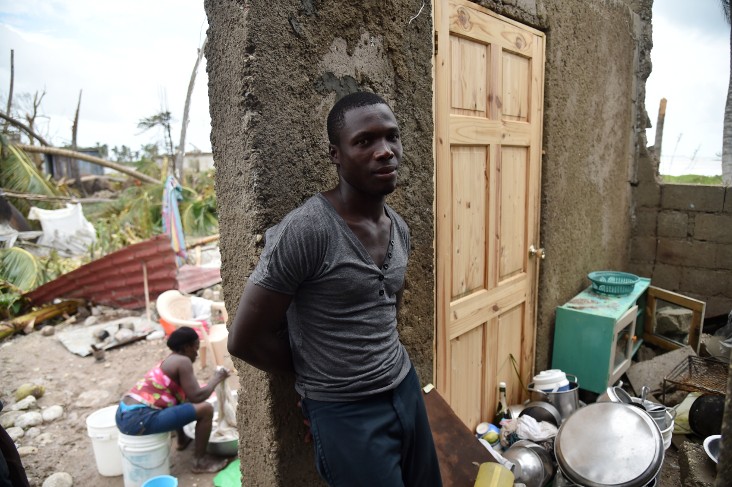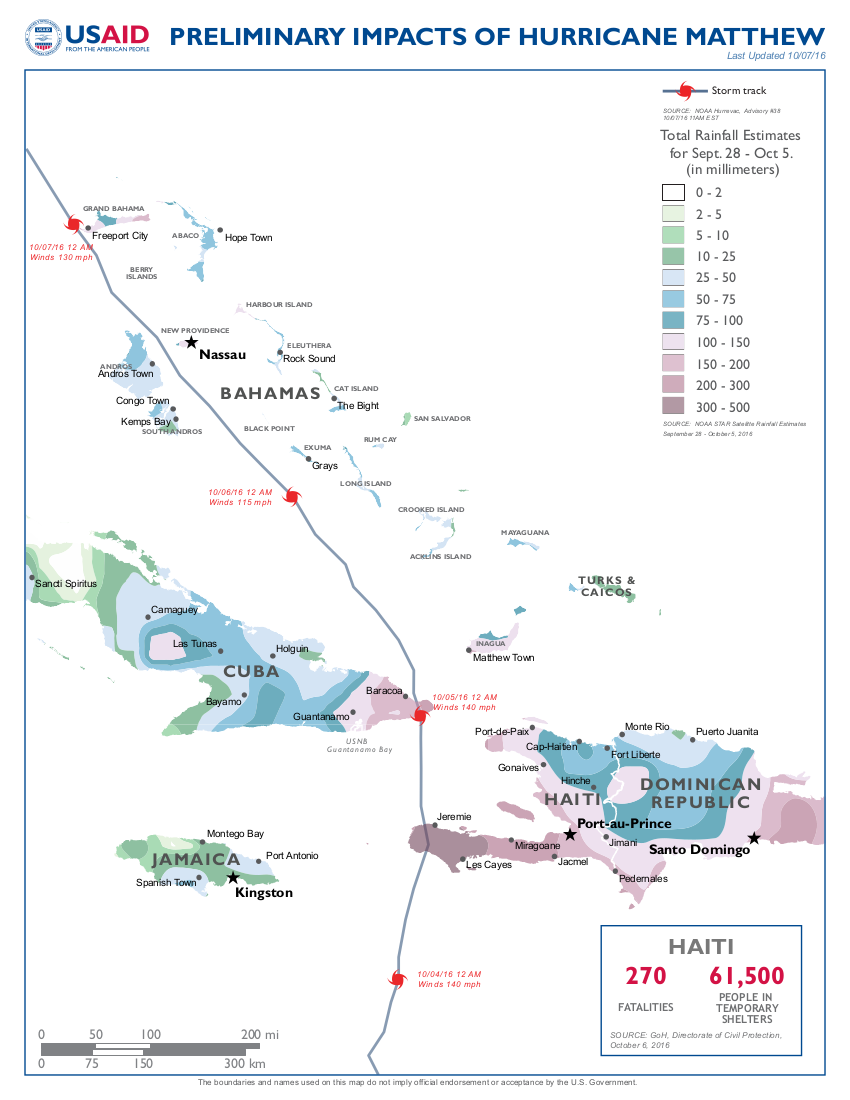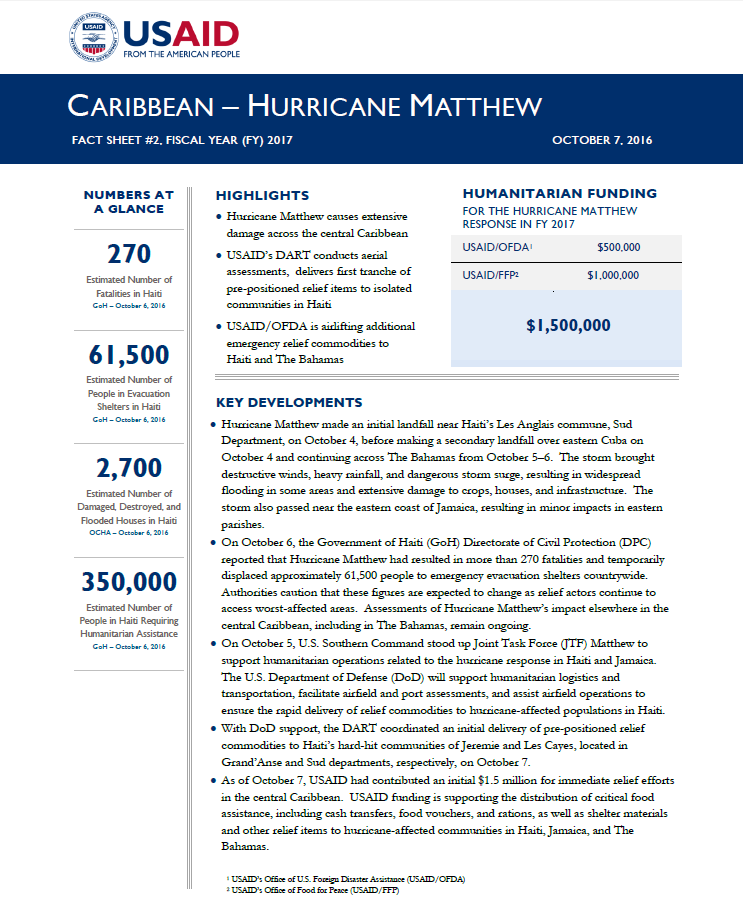October 7, 2016

Highlights
Hurricane Matthew causes extensive damage across the central Caribbean
USAID’s DART conducts aerial assessments, delivers first tranche of pre-positioned relief items to isolated communities in Haiti
USAID/OFDA is airlifting additional emergency relief commodities to Haiti and The Bahamas
Key Developments
Numbers At A Glance
270
61,500
2,700
350,000
Humanitarian Funding
For the Hurricane Matthew Response
in FY 2017
| USAID/OFDA | $500,000 |
| USAID/FFP | $1,000,000 |
| TOTAL | $1,500,000 |
Hurricane Matthew made an initial landfall near Haiti’s Les Anglais commune, Sud Department, on October 4, before making a secondary landfall over eastern Cuba on October 4 and continuing across The Bahamas from October 5–6. The storm brought destructive winds, heavy rainfall, and dangerous storm surge, resulting in widespread flooding in some areas and extensive damage to crops, houses, and infrastructure. The storm also passed near the eastern coast of Jamaica, resulting in minor impacts in eastern parishes.
On October 6, the Government of Haiti (GoH) Directorate of Civil Protection (DPC) reported that Hurricane Matthew had resulted in more than 270 fatalities and temporarily displaced approximately 61,500 people to emergency evacuation shelters countrywide. Authorities caution that these figures are expected to change as relief actors continue to access worst-affected areas. Assessments of Hurricane Matthew’s impact elsewhere in the central Caribbean, including in The Bahamas, remain ongoing.
On October 5, U.S. Southern Command stood up Joint Task Force (JTF) Matthew to support humanitarian operations related to the hurricane response in Haiti and Jamaica. The U.S. Department of Defense (DoD) will support humanitarian logistics and transportation, facilitate airfield and port assessments, and assist airfield operations to ensure the rapid delivery of relief commodities to hurricane-affected populations in Haiti.
With DoD support, the DART coordinated an initial delivery of pre-positioned relief commodities to Haiti’s hard-hit communities of Jeremie and Les Cayes, located in Grand’Anse and Sud departments, respectively, on October 7.
As of October 7, USAID had contributed an initial $1.5 million for immediate relief efforts in the central Caribbean. USAID funding is supporting the distribution of critical food assistance, including cash transfers, food vouchers, and rations, as well as shelter materials and other relief items to hurricane-affected communities in Haiti, Jamaica, and The Bahamas.
THE BAHAMAS
Hurricane Matthew passed over The Bahamas on October 6 and 7, bringing destructive winds, heavy rainfall, and dangerous storm surge. Although assessments of Hurricane Matthew’s impact in The Bahamas remain ongoing, USAID’s Disaster Assistance Response Team (DART) reports that the main areas of concern include Andros and Grand Bahama islands. In The Bahamas’ capital city of Nassau, the DART reported tree damage and minor structural damage, as well as ongoing debris-removal and repair efforts. Internet communications are functioning, but the storm damaged telephone wires, resulting in intermittent telephone service.
The Government of the Commonwealth of The Bahamas (GCoB) issued the all-clear in the morning of October 7, indicating that the storm had passed and people could safely leave shelters. The GCoB National Emergency Management Agency (NEMA) is assessing damages and planning initial response activities.
With U.S. Coast Guard support, the DART conducted an initial overflight of affected islands, including Andros and Grand Bahama, on October 7.
HAITI
The GoH, UN agencies, and other relief actors, including the DART, continue to assess the extent of hurricane-related damage, identify humanitarian needs, and mobilize response efforts in Haiti; however, access to affected areas, particularly the worst-affected departments of Grand’Anse and Sud, remains limited due to extensive damage to roads, bridges, and other infrastructure, as well as widespread flooding. As of October 6, initial estimates indicated that Hurricane Matthew had resulted in more than 270 fatalities and temporarily displaced approximately 61,500 people to emergency evacuation shelters countrywide, according to the GoH DPC. The DPC cautions that these figures are expected to change as assessments continue and relief actors continue to gain access to worst-affected areas. Hurricane Matthew had also damaged, destroyed, or flooded at least 2,700 houses, and caused extensive damage to agricultural lands, according to the UN. Although assessments remain ongoing, the DPC estimates that more than 350,000 people are in need of emergency assistance, including food assistance, safe drinking water, shelter support, and other emergency relief commodities.
In advance of the storm, USAID/OFDA pre-positioned emergency relief items—including blankets, hygiene kits, kitchen sets, and plastic sheeting—sufficient for 8,000 households in five warehouses in Haiti. With DoD support, the DART coordinated an initial delivery of pre-positioned relief commodities to Jeremie and Les Cayes on October 7. Additional relief commodity deliveries are planned in the coming days. USAID/OFDA is also coordinating the airlift of additional emergency relief items from USAID/OFDA warehouses in Miami, Florida, and Pisa, Italy, to Haiti, which are scheduled for arrival in the coming days.
In response to Hurricane Matthew, USAID/OFDA requested the unique capabilities of DoD to support USAID-led efforts to provide critical assistance to severely affected communities, particularly in the hardest-hit areas of Haiti’s southwestern peninsula. As a result, U.S. Southern Command stood up JTF Matthew on Oct. 5 to support the DART’s disaster relief efforts to deliver critical supplies and humanitarian personnel to areas cut off by the storm. The JTF will also support aerial assessments of areas affected by Hurricane Matthew and will coordinate with the USAID DART to conduct airfield and port assessments, in addition to providing airfield operations support. Four U.S. military helicopters carrying humanitarian personnel—including members of the DART—arrived in Haiti’s capital city of Portau- Prince on October 5. Five additional helicopters arrived in Haiti on October 7, bringing the cumulative number of DoD helicopters in country to nine. Additionally, the DoD has deployed over 350 U.S. military personnel to support response operations.
With U.S. Coast Guard support, the DART conducted initial aerial assessments of Grand’Anse and Sud on October 5 and 6, observing extensive structural damage to houses, public buildings, and roads, as well as severe flood damage in Grand’Anse. DoD and DART staff plan to conduct additional overflights in the coming days.
USAID/FFP committed $1 million to non-governmental organization (NGO) partner CARE on October 3 to address immediate needs resulting from Hurricane Matthew in Haiti. Provided in advance of the hurricane’s passage over Haiti, the funding allowed CARE to pre-position emergency assessment teams in Grand’Anse. As of October 6, USAID/FFP funding had enabled CARE to provide more than 9,000 hot meals and safe drinking water to people sheltering in temporary evacuation centers in Grand’Anse and other affected areas. USAID/FFP funding will also support CARE to continue distributing food vouchers, cash transfers, food rations, and meals for populations in emergency evacuation shelters across affected areas. In addition, USAID/FFP is supporting the UN World Food Program (WFP) to redirect existing funding—provided by USAID/FFP in FY 2016—toward the hurricane response. WFP reports current pre-positioned food supplies in Haiti are sufficient to support 300,000 people for one month. USAID/FFP continues to monitor the potential long-term impacts of Hurricane Matthew on food security in Haiti, particularly as the hurricane’s passage coincided with the country’s fall planting season and other harvests.
WFP plans to deploy teams to conduct emergency food security and food market availability assessments in Grand’Anse, Nord-Ouest, Nippes, Sud, and Sud-Est departments in the coming days; preliminary estimates suggest up to 80 percent harvest loss in some affected areas, raising concerns over the long-term impact on food security, according the UN. The organization plans to distribute approximately 22 metric tons of pre-positioned emergency food assistance—sufficient to meet the food needs of 9,000 people for one week—to hurricane-affected populations in Jeremie in the coming days.
Since October 4, the DPC has confirmed 10 new cases of cholera, including six cases in Sud and four cases in Sud-Est. As of mid-September, the UN World Health Organization had recorded nearly 26,800 cholera cases in Haiti in 2016. International health actors, including USAID/OFDA partner the Pan American Health Organization (PAHO), are coordinating measures to prevent and respond to a possible increase in cholera cases, resulting in the aftermath of Hurricane Matthew. As of October 6, PAHO had activated more than 30 staff, including experts in emergency medicine, health coordination, field epidemiology, and logistics and supply management, and was collaborating with the GoH Ministry of Health to enhance surveillance and identify high-risk areas.

To help prevent possible cholera cases in the aftermath of Hurricane Matthew, the DART is prioritizing the delivery of hygiene kits and water treatment supplies and storage systems, with supplies expected to arrive in Haiti in the coming days. In addition, a U.S. Centers for Disease Control and Prevention (CDC) representative on the DART is coordinating potential prevention and response measures with GoH health officials, PAHO, and other local relief actors. The DART’s efforts build on the ongoing work of CDC and USAID/Haiti since the 2010 cholera outbreak.
On October 6, the International Federation of Red Cross and Red Crescent Societies (IFRC) launched an emergency appeal for 6.8 million Swiss Francs—approximately $6.9 million—to support the Haiti Red Cross (HRC) to respond to the humanitarian needs of 50,000 people in Haiti. In coordination with the HRC, IFRC plans to provide emergency health care, shelter, and water, sanitation, and hygiene support to hurricane-affected populations. In advance of the storm, IFRC pre-positioned emergency relief items, including blankets, kitchen sets, plastic sheeting, and water purification tablets, and mobilized more than 3,000 staff and volunteers to support immediate response efforts.
Since 2005, USAID/OFDA has provided more than $17 million to improve disaster risk reduction (DRR) efforts in Haiti. DRR efforts enable partners to conduct flood mitigation and hurricane season preparedness at the local and national levels; pre-position critical emergency relief supplies; and strengthen emergency operation center capacity in collaboration with the GoH, NGOs, and UN agencies.
JAMAICA
On October 4, DART staff conducted assessments in eastern Jamaica’s Portland and Saint Thomas parishes, where the storm was expected to have the most significant impacts. Assessment findings indicated minimal damage to coastal areas, including some blocked roadways and sea incursion along shorelines, resulting from hurricane-related winds and storm surges. DART staff also identified a water main damaged by sea incursion in Portland’s Manchioneal town; however, the assessments found that normal commercial activities had otherwise largely resumed. A joint rapid assessment conducted by the Government of Jamaica (GoJ) Office of Disaster Preparedness and Emergency Management and the UN Disaster Assessment and Coordination team in Jamaica revealed similar findings, noting only minor impacts of Hurricane Matthew in eastern Jamaica.
As of October 6, the GoJ had closed all but two emergency evacuation shelters, and airports, businesses, and GoJ departments and agencies had resumed regular operations, according to the UN Office for the Coordination of Humanitarian Affairs (OCHA) and DART staff.
Based on assessment findings, and in consultation with GoJ representatives, USAID/OFDA began scaling down DART operations in Jamaica on October 5, relocating three staff from Jamaica to Haiti via DoD aircraft. Locally-based USAID/OFDA staff will continue to monitor USAID/OFDA assistance provided to the Jamaica Red Cross (JRC) to address the immediate needs of populations affected by Hurricane Matthew.
CUBA
Initial reports indicate that Hurricane Mathew—which made landfall over Cuba as a Category 4 storm on October 4— caused extensive damage to houses and infrastructure in the eastern provinces of Guantanamo and Holguin, according to the UN Office of the Resident Coordinator (ORC) in Cuba. As of 9:00 p.m. local time on October 5, more than 176,000 people in five of Guantanamo’s 10 municipalities, including Baracoa, Imias, Maisi, San Antonio del Sur, and Yateras, remained isolated following the storm’s passage. Current estimates indicate that 90 percent of houses in Baracoa sustained damage due to the storm. Additionally, the ORC reports that damage to two of Baracoa’s primary cash crops—cocoa and coconut—is likely to impede livelihoods throughout the municipality.
As of October 5, approximately 135,000 people remained in Government of Cuba (GoC)-managed protection centers and other GoC institutions, the ORC reports. In addition, an estimated 1 million in Baracoa and Maisi remained displaced. Authorities have not reported any causalities resulting from the storm.
The Cuban Civil Defense is leading immediate response efforts, including conducting aerial assessments and identifying priority response needs. As of October 7, the GoC had not made a request for USG cooperation.
CONTEXT
Hurricane Matthew made an initial landfall near Haiti’s Les Anglais commune, Sud Department, on October 4, before making a secondary landfall over eastern Cuba on October 4 and continuing to traverse The Bahamas from October 5–6. The storm brought destructive winds, heavy rainfall, and dangerous storm surge, resulting in extensive damage to crops, houses, and infrastructure, as well as widespread flooding in some areas.
On October 2, U.S. Ambassador to Haiti Peter F. Mulrean and U.S. Chargé d’Affaires, a.i., for Jamaica Eric Khant issued disaster declarations in response to the anticipated effects of Hurricane Matthew in Haiti and Jamaica, respectively. U.S. Chargé d’Affaires, a.i., Lisa A. Johnson issued a disaster declaration in response to the anticipated effects of Hurricane Matthew in The Bahamas on October 3.
USAID activated a regional DART on October 3 with staff in The Bahamas, Haiti, and Jamaica. In addition, USAID stood up a Washington, D.C.-based RMT to coordinate the regional humanitarian response.









Comment
Make a general inquiry or suggest an improvement.